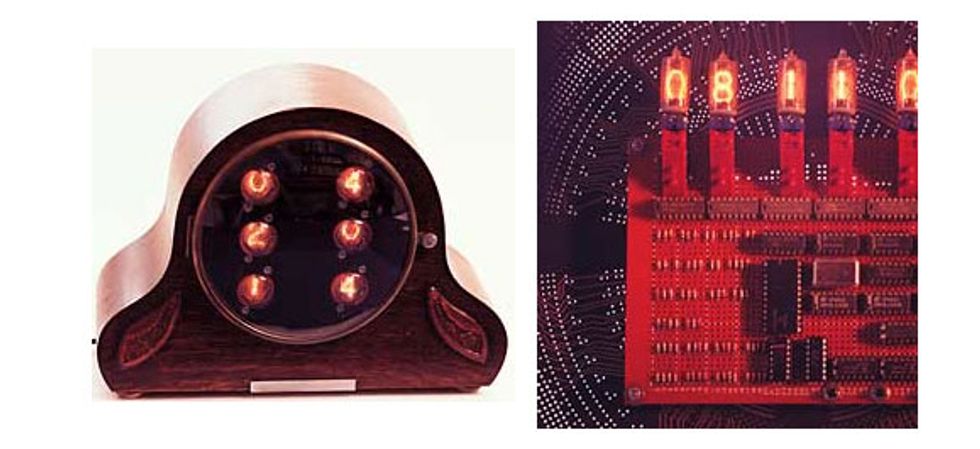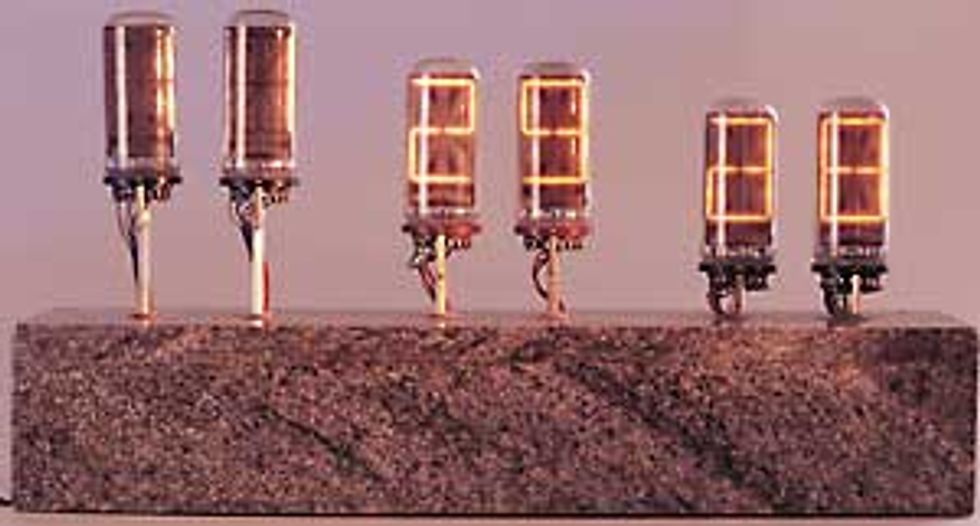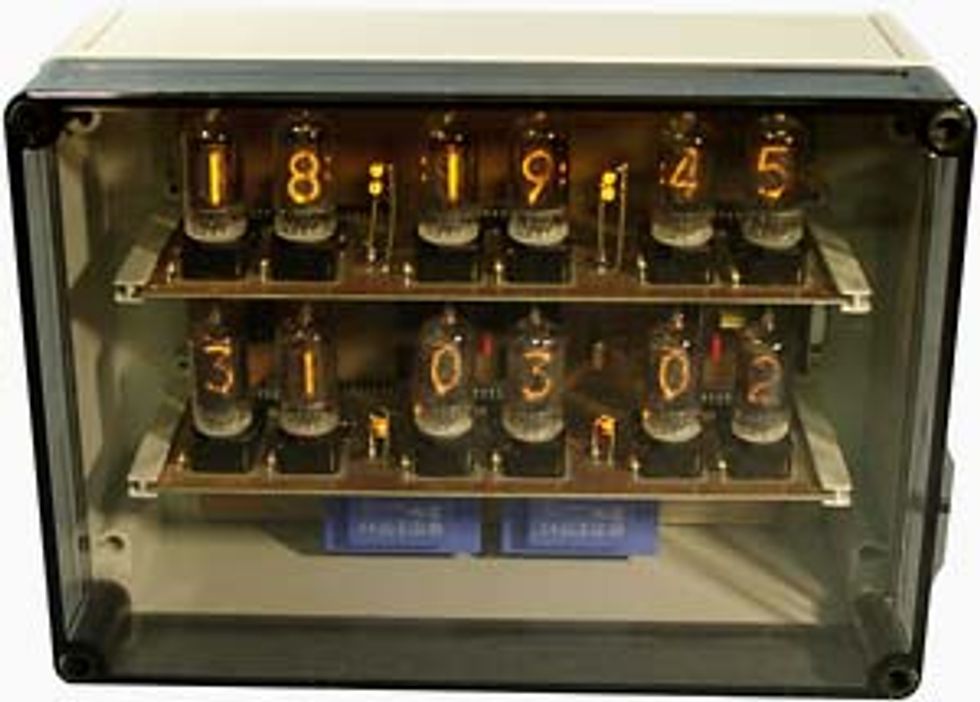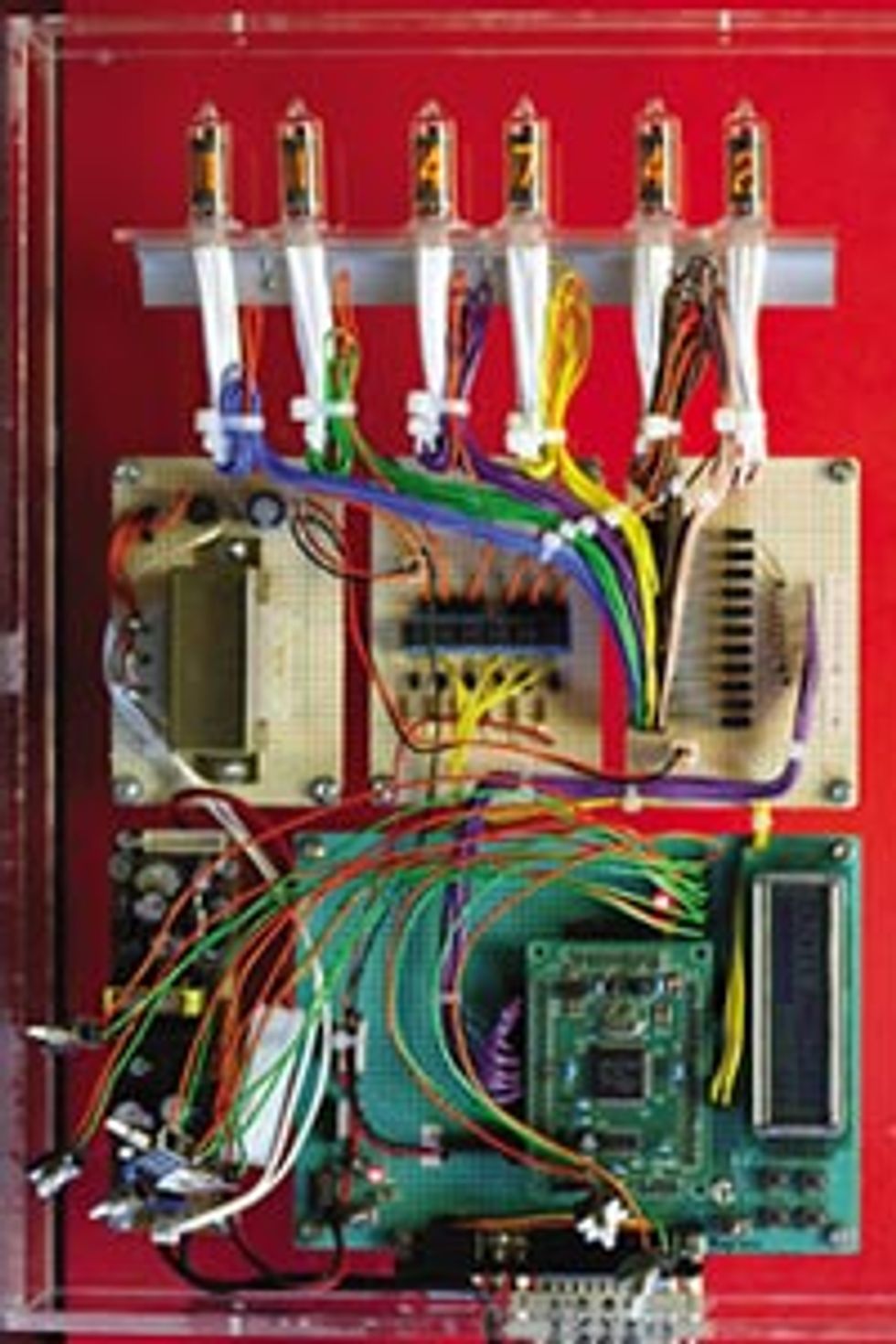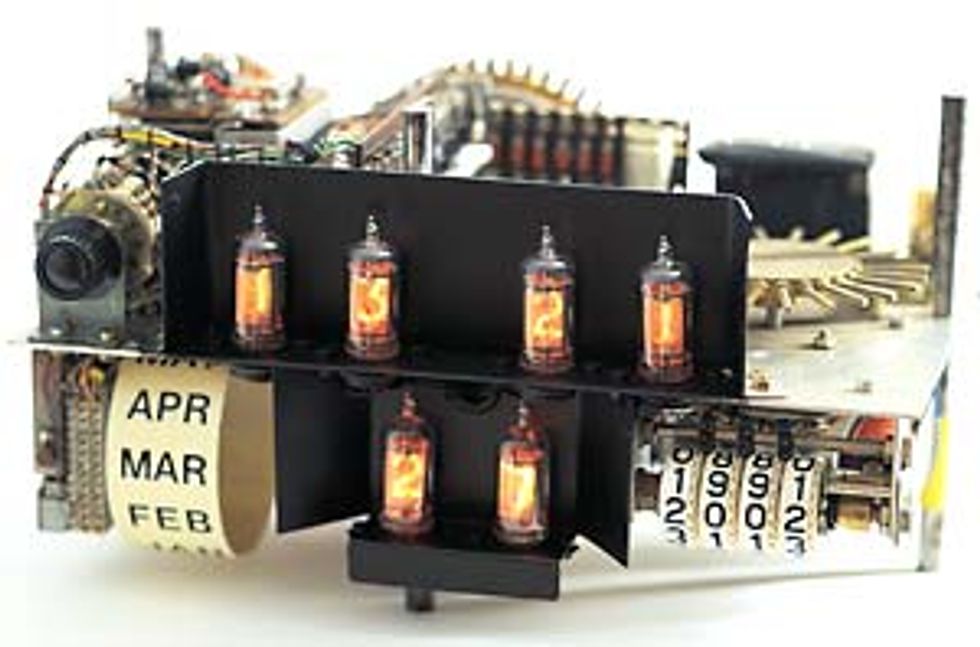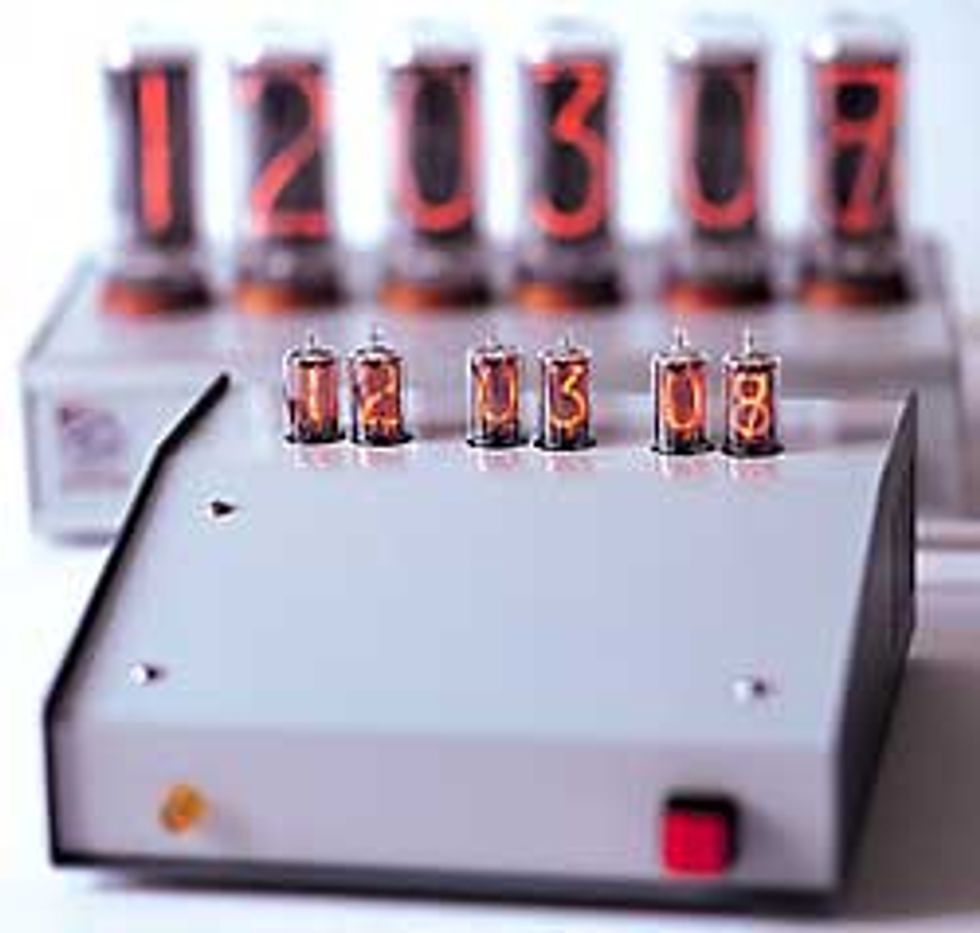New Life For Nixies
Novel digital clocks get their glamour from the Nixie tube, the mother of electronic numerical displays
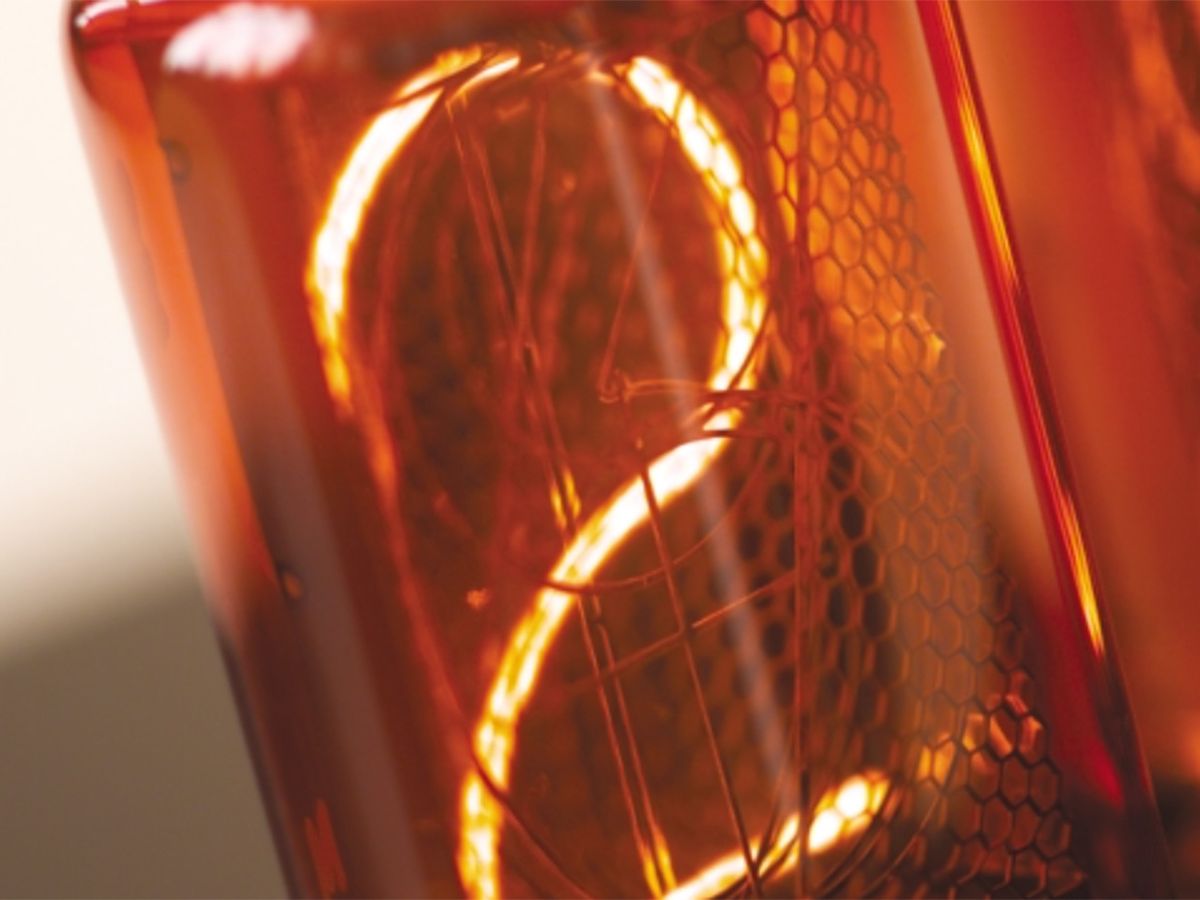
They were tagged with the unfortunate name NIX-1, for Numeric Indicator Experimental-1. But by the time they hit the streets, in 1954, they had been nicknamed Nixie, and they arrived just in time to become the warm, reassuring face of electronics’ heady adolescence. They went on to literally light up the New York Stock Exchange, cruise under the sea aboard Navy submarines, and wink by the hundreds at NASA mission controllers guiding rockets to the moon.
A Nixie is basically a set of diodes in a glass tube containing a little neon gas. The cathodes are numerals, lined up one behind the other. Voltage applied to one ionizes the surrounding neon, and the numeral seems to light up.
If it is possible for an electronic component to be beloved, surely Nixie tubes were. With their graceful digits glowing a pleasing orange, they lent a touch of class to all kinds of 1950s and 1960s electronica, from voltmeters to desk calculators. But in the end, like long-playing records and British sports cars, Nixies were eclipsed by more practical and rugged successors. They lost ground in the 1970s, ultimately to seven-segment LEDs.
Now, though, Nixies are staging a spirited comeback. Home hobbyists have given the design cognoscenti something new to covet: a digital clock with a Nixie-tube display. Several organizations in the United States and Europe are selling them ready-made for prices between US $250 and $1200. The photos that follow, of clocks by hobbyists, testify to the ingenuity and creativity that these builders are bringing to their clocks.
The new appreciation of Nixies is due in no small measure to one Mike Harrison, a consultant near London who designed an elegant, robust, and versatile clock circuit based on inexpensive components and posted it on his Web site (https://www.netcomuk.co.uk/~wwl/nixclock.html). The site has had 100 000 hits over the past couple of years, Harrison reports.
Although Nixies have not been manufactured in the United States or Europe for a quarter century, treasure hunters still occasionally stumble upon a trove of tubes in a warehouse. Garden-variety unused Nixies can still be bought for $8-$20 a tube (or even less on eBay). But connoisseurs now treat some remaining stocks like vintage wine, bidding as much as $450 apiece for certain rare and coveted tubes (typically giants up to 15 cm long).
Ironically, in their heyday Nixies were seldom used in clocks. A set of tubes and the required chips would have priced a clock too far above the mechanical kind. Such a timepiece isn’t exactly cheap today, either, but now it seems an ideal if belated use for Nixies. Not only do the tubes put a delicate and whimsical face on the most utilitarian of appliances, their authentically retro look is a vivid reminder of the passage of time. They call to mind an era when horn-rimmed eyeglasses and pocket protectors were more than cheap Hollywood props.
“They’re like little electronic campfires,” says Walter Shawlee II, an IEEE associate member and owner of Sphere Research Corp. (Kelowna, B.C., Canada) (https://www.sphere.bc.ca/), an instrumentation contracting company that also sells Nixies and other technology artifacts. Contemplating the enduring appreciation of Nixies, Shawlee adds, “People have this wistful longing for the stuff that looks better.”
Timely Obsession
David (“Westdave”) Weiner, Los Angeles
David Weiner built his first clock in a shop class in high school in 1972: six Nixie tubes in a lovingly crafted mahogany case. It was the start of something big. In the 30 years since, he has built 100 clocks, he estimates, most of them with a Nixie display. His mantel clock [above, left] is a fine example of “out with the old, in with the new.” First he extracted the eight-day wind-up mechanism from an antique clock. Then he replaced it with an electronic circuit wired to a six-Nixie-tube display. The clock circuit, as in most of his creations, is based on a 10-MHz crystal oscillator, with ICs to divide the frequency down to 1 Hz.
Some day, Weiner—who keeps six clocks in his bedroom—may run out of Nixies, but that day is distant. An ardent devotee of eBay, he has accumulated a cache of 450 tubes.
200 V at the Flick of a Wrist
Jeff Thomas, Mesa, Ariz.
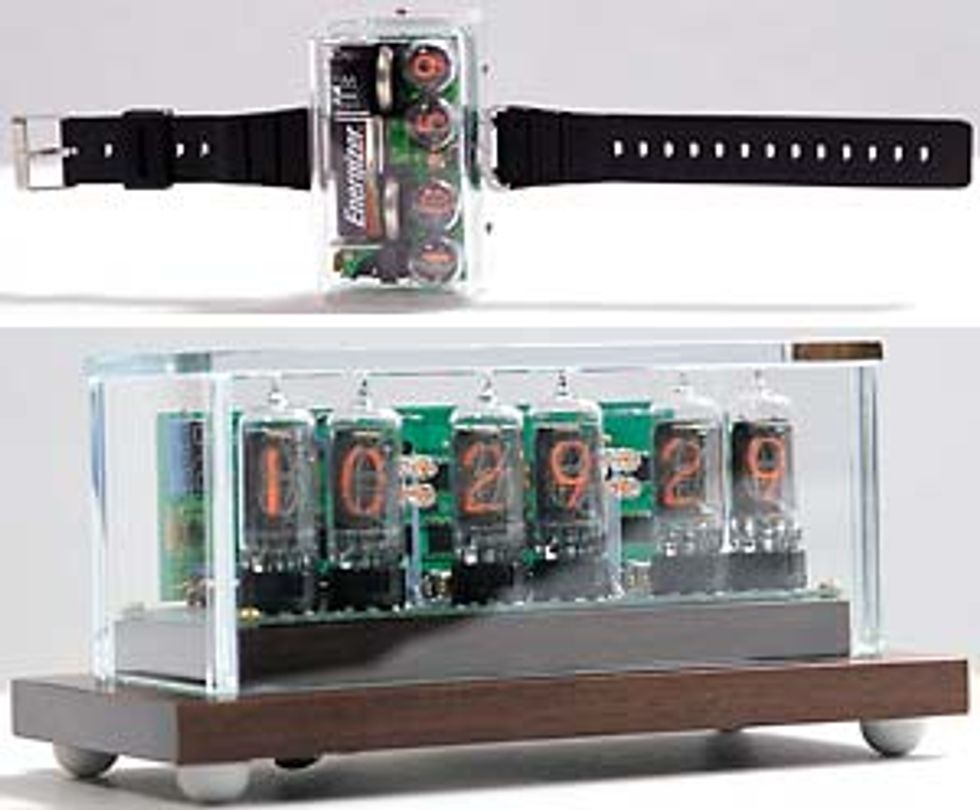
A Nixie clock small enough to wear on your wrist? It was a challenge Jeff Thomas couldn’t pass up [right, top]. The idea for the watch “came from the movie Brazil—a strange flick where technology had become stalled, distorted,” he explains. “A friend had seen this movie and asked if a Nixie wristwatch had ever been made.” Turned out it hadn’t been done. After all, how do you produce, within the space of a wristwatch, the tubes’ 200 Vdc?
“One day I was playing with a disposable flash camera,” Thomas goes on. “I noticed that the circuit used to generate the high-voltage dc for the flash comprised only three components: a transistor for oscillation, a tapped transformer, and a diode rectifier. The circuit generated 200 V at 2 mA from a single AA battery. Ah ha!” The next pieceof the puzzle came to him at an auction of military equipment at Hickam Field in Hawaii, where he ran across 80 aspirin-sized NL-7977 Nixie tubes from National Electronics.
He used them to make 20 watches and gave most away as gifts. Once he was wearing his own in a shopping mall when a teenager asked, “Dude, is that one of those house-arrest thingies?”
Turning the recent economic dry spell to advantage (his company, Resonant Instruments, makes semiconductor wafer probing equipment), Thomas also put together a series of desk clocks [right]. He gave away seven and sold another 20 faster than he could make them. Still, the Nixie look isn’t for everyone. Thomas’s wife banished his own clock to a desk in his study.
The Long and Short of It
Mike Harrison, Loughton, Essex, UK
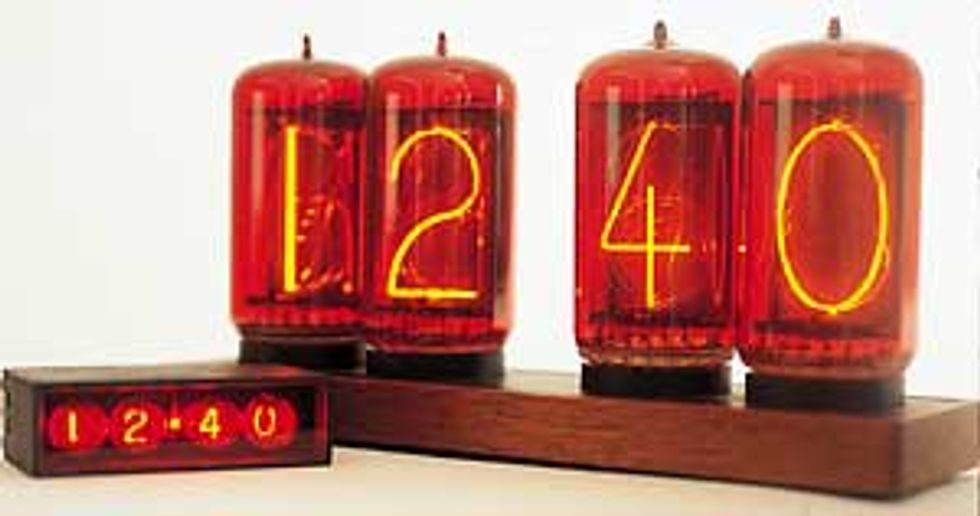
It was only a matter of time before Mike Harrison, who has long been interested in spark-gap tubes, thyratrons, and other exotic electronic glassware, turned his attention to Nixie tubes. When he did, the results were extreme: his habit of building ever larger clocks culminated in a unit adorned with rare East German Z568M tubes boasting digits 50 mm tall [right, top]. Sockets for the tubes are long gone, so he made his own, using a printed-circuit board and receptacles from a dismantled D connector. The time-keeping circuit is the sturdy, versatile one Harrison designed and posted on his Web site (https://www.netcomuk.co.uk/~wwl/nixclock.html).
After building the big clock, he resolved to make a tiny one for his car [above, foreground, and at right]. Through a fellow tube collector, he obtained some small Japanese Nixie tubes and crafted a surface-mounted circuit based on three stacked pc boards. The clock, which measures 80 by 25 by 45 mm, has a built-in dc-dc converter to step the car’s 12 V up to the 200 V required by the tubes.
Childhood Fascination
Ralf Spettel, Weilerbach, Germany
As a child, Ralf Spettel was enchanted with a few mysterious glass tubes he kept in a drawer. When he grew older, he found out they were called Nixie tubes, and after a few Web searches, he learned how to make them glow. The next step, of course, was to build a clock. His large radio-controlled clock [right] synchronizes itself with signals from the atomic clock at the Physikalisch-Technische Bundes- anstalt in Braunschweig, Germany.
“I’m usually too lazy to set the correct time,” he says—not very convincingly because he was industrious enough to produce an elegant design based on a 90S8515 microcontroller and impeccable circuit boards. In a new version of the clock [not shown], he dispensed with the calendar function and put a smaller versIon of the clock, also radio controlled, in a handsome wood case.
Where in the World?
Katsushi Matsubayahi, Tokyo
The simplest way for an electronic clock to keep time is to count cycles of house current, and that’s what many Nixie-tube clocks do. But not Katsushi Matsubayashi’s. His receives signals from the U.S. Defense Department’s Global Positioning System (GPS) satellites. The orbiters provide the clock with not only submillisecond accuracy but also the date and the clock’s latitude, longitude, altitude, speed, and bearing.
Admittedly, the position data aren’t much use to Matsubayashi, who keeps his clock in his rather stationary office at the Tokyo National College of Technology, where he is an associate professor of mechanical engineering. But the clock has been a big hit there: “Some teaching colleagues feel nostalgic towards it; some students are surprised at GPS, and get interested in vacuum tubes, which they have never seen before,” he writes.
When trying to decide what kind of case to put the clock in, he got sharply differing views from co-workers. “The teaching staff in mechanical engineering suggested that the circuit should be clearly seen from the outside, whereas those in electrical engineering suggested the circuit should not be seen from the outside,” Matsubayashi reports. “If gears or motors had been used, their suggestions might have been reversed.”
No Transistors Needed
Geoff Tomlin, Ipswich, Suffolk, UK
There are basically two ways to switch the 200 Vdc that light a digit in a Nixie tube. You can use a cheap small-signal transistor, or you can splurge and use a 74141 IC, which has the high-voltage transistors built in. Geoff Tomlin rejected both approaches and opted for an evocative assemblage of rotary switches. As a high school senior in 1969, inspired by an article in an electronics magazine, Tomlin built a clock using military surplus rotary switches to apply the high voltage to the appropriate Nixie digit in sequence. The time reference is a one- revolution- per-minute synchronous motor; gears divide this time reference to turn the hour and minute rotary switches at the proper rates.
Tomlin didn’t stop there. He designed other electromechanical assemblies based on diodes, switches, or impulse counters to automatically keep track of the day, month, and year (for another 8000 years—how’s that for youthful optimism?). However, he could not get the day and year selectors to work properly before he went off to college and became an EE with the telephone company. He never forgot his clock, though, and now, 33 years later, he pledges to “get it fully working.” The year 9999 awaits.
Happy Hour
Gary Bleads, South Manchester, UK
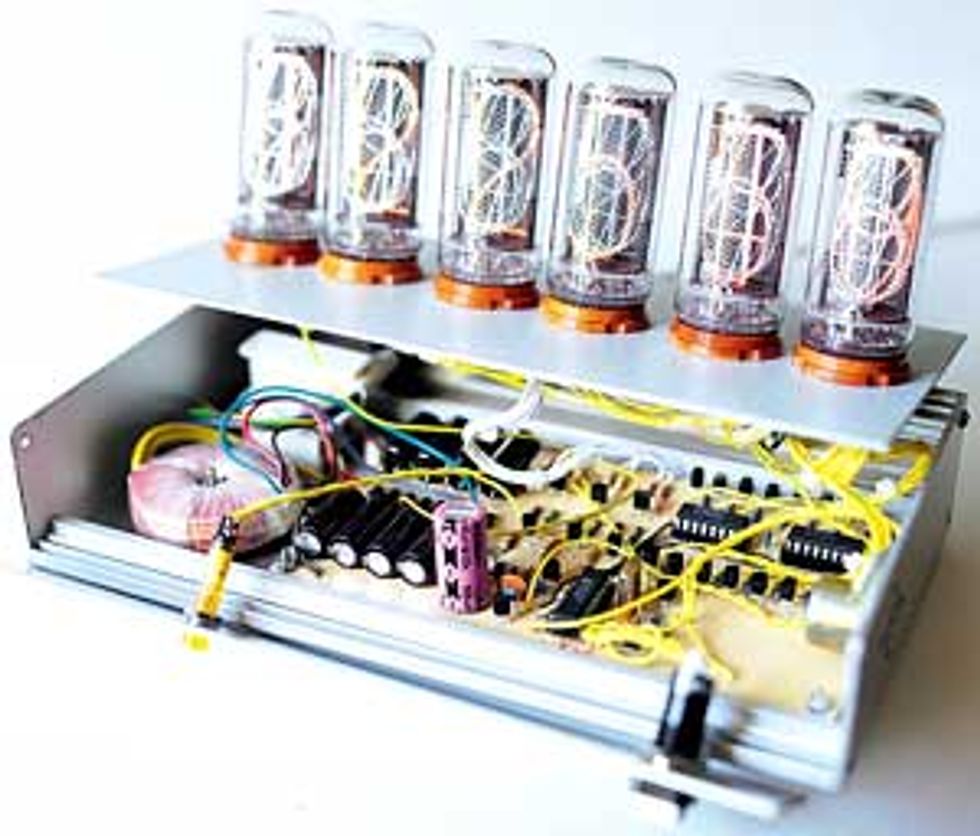
Gary Bleads’s bedside clock [top right] is probably a lot nicer than yours. The clock not only has an alarm, but chimes gently every 15 minutes, except when Bleads is in bed, between 11 p.m. and 10 a.m. The circuit also automatically dims the display at night by strobing it rapidly on and off. The clock is based on a PIC16F84 microcontroller, which counts the cycles of the 50-Hz house current where he lives.
The chimes and alarm are both software-generated square waves. For the chimes, he simulated the decaying sound of a bell’s “ding” by changing the ratio of the square wave’s on and off parts. “The chimes are very useful when I’m busy, as they remind me when it’s time to go to the pub,” he reports. His new clock [bottom right] uses 46-mm Russian Nixies and consolidates the circuitry on one circuit board. “It does seem bizarre to be driving antique tubes from modern microprocessors,” he concedes. “But that’s half the fun.”
To Probe Further
Mike Harrison’s Web site, https://www.netcomuk.co.uk/~wwl/nixclock.html, is the first stop for any Nixie enthusiast. It has complete details, parts lists, schematics, and even downloadable PC-board layouts for building your own clock.
An excellent diagram showing how a Nixie tube works is to be seen at https://www.cse.uconn.edu/cse/Courses/CSE208W/NumberConversion/Nixie.html. A nicely designed site with some fascinating lore and early history of the tube is at https://www.wps.com/texts/decimal-tubes/. The Yahoo! discussion group on Nixies is https://groups.yahoo.com/group/NEONIXIE-L/.
Most of the clock builders in our article have Web sites, and some also offer clocks for sale. See:
- https://www.westdave.com/ (David “Westdave” Weiner)
- https://www.spettel.de/ralf/projekte/nixieclock/ (Ralf Spettel)
- https://www.amug.org/~jthomas/clockpage.html (Jeff Thomas)
- https://www.stockportradiosociety.co.uk/folderindex.asp (Gary Bleads)
- https://www.uhrenliteratur.de/nixie/nixie.htm (Konrad Metzger)
